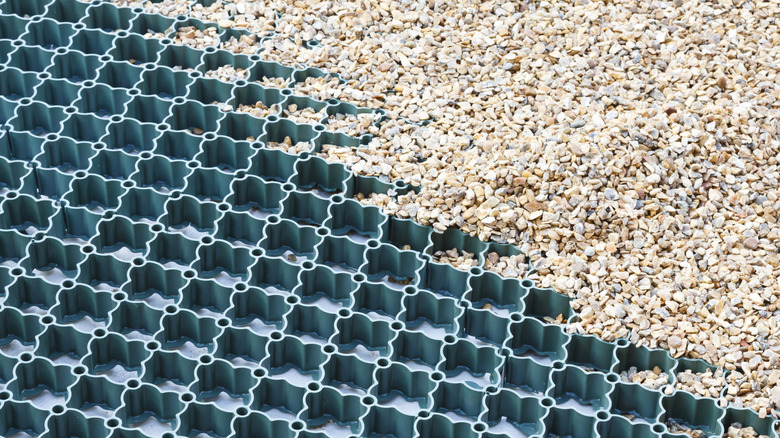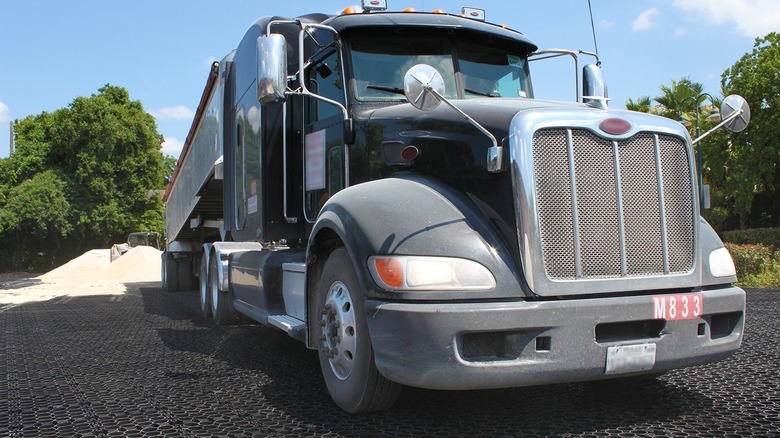The Gravel Drive Grid System We're Not Sure You Need, Here's Why
We may receive a commission on purchases made from links.
Gravel driveways are versatile, durable, affordable, and attractive. They can be equally appealing in front of virtually any style of architecture, from classic brick-built colonial to a sleek, contemporary home. Unlike pavers or asphalt, gravel driveways can be a relatively easy DIY installation: Simply choose the best underlayment for the driveway, pour the gravel on top, and rake it level. A gravel grid system adds an extra task to the process but is touted as a way to provide a stable surface and minimize ongoing maintenance.
Gravel grids (often called permeable pavers) are interlocking plastic mats comprising rows of small pockets that hold the gravel (or crushed rock) in place. TRUEGRID PRO Plus Permeable Pavers are a good example. Although sizes vary, each paver is usually around 2 feet square and a couple of inches deep. They click together easily without the need for tools. The driveway material is then added to the pockets until they are full. Some suggest using a plate compactor with crushed rock, though doing so may damage decorative gravel.
Now, do you really need a gravel grid system? If you don't mind a little exercise and following a few pointers for maintaining your gravel driveway, we're not sure that you do. Yes, they save time if your driveway is on a slope (or you just hate raking). On the other hand, if your driveway is flat, their benefits are less clear, and there are some who say they're both expensive and unnecessary. Much is made of their permeability, but gravel is usually permeable anyway. Let's take a more detailed look at the pros and cons.
The benefits of a gravel grid system
Most driveways have vehicles driving on them to and fro on a regular basis. Regardless of the size and weight of these, they eventually leave ruts in the gravel surface that need to be raked level again. There are a number of other reasons for raking a driveway regularly, and it can be a bit of a chore. A gravel grid system holds the contents in place. The grids themselves have a load rating of 80,000 pounds or more, so there's no danger of them being damaged, even if you drive a semi.
If your driveway is on a slope, raking will likely be needed even more often, as gravel tends to roll downhill whether there's traffic or not. A gravel grid will keep it in place. While an ordinary gravel driveway cannot be plowed when covered in snow, one constructed with gravel grids can. Some people argue against using more plastics in the garden, which is a valid point, but many gravel grids are made using 100% recycled materials.
Why you might not want to use gravel grid systems
First, there's the cost. Typically, gravel grid systems cost between $4 and $5 per square foot — and that's without the gravel. At this price, your gravel driveway could become as expensive as asphalt and close to some pavers. However, that's only really a consideration if you've yet to decide on material. Then there's the time involved. Although individual pavers lock together easily, if you have several hundred square feet of driveway to cover, assembly is going to take a while. It also takes longer to fill the pockets than simply raking gravel.
Appearance may also be an issue. While most of the plastic pavers are covered, the top edges will be visible if the content settles (or if you plow it). Topping these permeable pavers up periodically with gravel could be as much of a pain as raking. In truth, one manufacturer's promotional video suggests that the gravel grid system was primarily intended for commercial installations, and domestic use is secondary.


